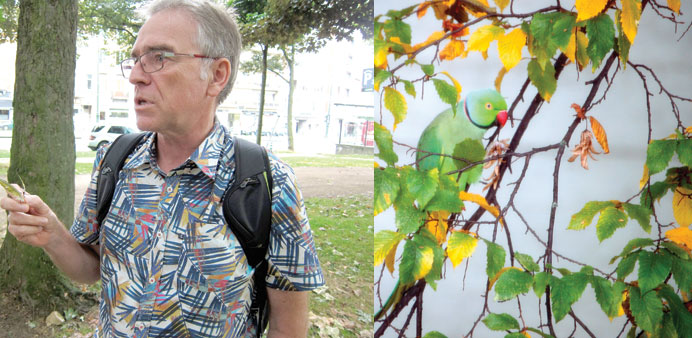Alain Paquet of the Belgian nature-protection organization Natagora speaks about parrots in a Brussels park. Natagora has been doing a census of Psittacula krameri. Right: NUISANCE OR BLESSING? A rose-ringed parakeet in a European tree in a Brussels park. The species — scientific name Psittacula krameri — is native to Asia and Africa.
By Alexandra Mayer-Hohdahl
A species of bright-green, red-beaked parakeet, originally stemming from India, has been steadily spreading through the Belgian capital Brussels for the past four decades.
Thousands of the birds — scientific name Psittacula krameri — live in Brussels parks, alongside indigenous pigeons and woodpeckers.
Some people in the northern European city, best known as the headquarters of the European Union, welcome the birds as an exotic delight, but others decry them as a screeching nuisance or a dangerous invasive species. Even specialists are divided on whether the wild parakeets should be preserved or eliminated.
“At the beginning, people think they’re pretty and then, when they start multiplying, people say ‘oh la la la, that’s not normal!’” ornithologist Alain Paquet exclaimed on a recent summer morning.
“There is the same attitude vis-a-vis exotic birds as there is vis-a-vis foreign workers,” Paquet said with a smile, drawing a comparison with recent criticism of immigrants who have tried to reach Europe.
“People use exactly the same arguments: the parakeets will take away the housing of our birds. The parakeets will damage our economy, for instance by eating the buds of fruit trees. Our indigenous local fauna will suffer,” he said. “But Belgians have to understand that [parakeets] will remain part of the Belgian landscape.”
The country’s population of rose-ringed parakeets is the third-largest in Europe after colonies living in Britain and the Netherlands, according to research done for ParrotNet, a European network of researchers.
It estimated that the population size in Brussels reached 9,350 birds this year, but a new census being carried out by Natagora — the environmental organisation that Paquet works for — puts their numbers at around 7,000 in Brussels and a total of 8,000 in Belgium.
The birds have long been known to thrive in European cities when captives are released, surviving thanks to urban heat, bird feeders and nesting holes in tree-dotted parks.
The numbers in Brussels are down, however, from a high of more than 10,000 in 2011. Some of the so-called dormitories where thousands of parakeets gather to sleep at night have splintered, with birds scattering to other cities north and south of Brussels, Paquet said.
What is causing the changes is unknown, but the ornithologist noted that peregrine falcons, one of the parakeets’ predators, have made a comeback in Belgium — 12 pairs are known to be living in Brussels.
The rose-ringed parakeets may also be under pressure from larger, more aggressive brethren whose numbers are on the rise in the city, Paquet said: the Alexandrine parakeet.
The rose-ringed parakeet’s origins have been traced back to a group of 40 birds that were released in 1974 by the Meli amusement park in Brussels, but it is unclear how the Alexandrine parakeet was introduced in the late 1990s, Paquet said.
Natagora is keeping a careful eye on the species to ensure that it does not change the record in Belgium of parakeets causing relatively little harm, Paquet said.
In places with fewer trees than Brussels, parakeets have been known to crowd out indigenous birds from nesting holes. The birds have also damaged agricultural crops in countries with warmer climates which allow them to venture outside cities.
“In its native range, mainly in India, it’s known as one of the worst avian pests,” said Diederik Strubbe, a researcher at the University of Antwerp. “But at the moment, real evidence from Europe is lacking to prove that it is such a harmful invasive [species].”
The rose-ringed parakeet is nevertheless among “the top 100 worst alien species in Europe,” with a total estimated population of 79,500 stretching across Belgium, Britain, France, Germany, Greece, Italy, the Netherlands, Portugal, Spain and Turkey, according to ParrotNet.
Parakeets are being considered for a new list of invasive alien species of concern that is being drawn up by the European Union, according to the European Commission. A listing would lead to a ban on imports and breeding of the species, but the move is seen as unlikely because of resistance in certain EU member states.
In the meantime, some have tried to make life a bit more uncomfortable for the parakeets in Brussels.
The NATO military alliance, whose Brussels headquarters was home to one of the city’s biggest parakeet dormitories, in the past called in falconers and put up loudspeakers to play the cries of birds of prey.
“While there are still parakeets on site, we have discouraged the birds from settling in areas that would cause a significant nuisance,” a NATO official told dpa, pointing to noise, droppings and the eating-away of “insulation on technical installations” as issues.
Authorities in Brussels, meanwhile, are cautiously tolerating the birds.
“People fear that they could supplant indigenous animal species. Bruxelles Environnement - IBGE is ensuring that this does not occur,” the agency responsible for environmental issues in the city says on its website.
But an eradication campaign is thought to be impossible in Brussels, given the parakeets’ numbers and the public backlash that would likely follow.
“Even if you have just a suggestion that [authorities] are going to kill parakeets or do something about them, then often they are flooded with angry emails,” Strubbe noted.
“Some people are very attached to the parakeets,” Corentin Rousseau of the Royal Belgian League for the Protection of Birds said on a recent afternoon, as he watched a woman in a park feed breadcrumbs to pigeons and Monk parakeets — a third species found in Brussels.
“There would be an outcry if the administration tried to eliminate them,” he added. —dpa


